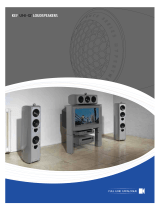
6 Silver Series 7G
The Effects of Bi-Wiring and Bi-Amping
Fundamentally a loudspeaker crossover varies the impedance seen by the speaker and by the power
amplier. The situation is such that when the full range musical signal is applied to the terminals of a full-
range speaker system, the bass driver(s) will only receive low frequency signals, the mid driver receives
the mid band frequency signals and the tweeter only gets sent high frequency signals. This means that if
separate speaker cables are connected to the low and high frequency terminals, not only have the drive
units had the frequency’s directed and divided for them, but the two separate speaker cables will now also
carry different signals, the bass cable mostly the lows, and the tweeter cable mostly the highs.
Once the high and low frequencies have been separated in this fashion, the strong current pulses and
surges demanded by bass drivers when reproducing bass or drums, will not interact with the delicate
sounds of a ute or cymbal.
In a single wired system, unwanted mechanical and electrical resonances manifest as distortion at both
sets of speaker terminals. Due to the impedance of the speaker cables, these distortions will not be entirely
cancelled by the amplier. Instead, they modulate between the two crossovers, and degrade sound quality.
When bi-wiring, this interaction is minimised as signal distortion is ‘seen’ at the amplier’s output where it
can be more effectively cancelled. Bi-wiring/ bi-amping therefore presents a ‘cleaner’ signal at both the
low frequency and high frequency speaker terminals, and because the high and low frequencies have
already been separated, each has a minimal effect on the other - in essence the bass does not overpower
delicate treble.
In terms of the audible benet, bi-wiring/ bi-amping, provides more clarity and detail to the midrange and
high frequencies. Often the bass will become faster and tighter. Focus and staging will improve as well. In
all, this is a very effective and desirable improvement and is highly recommended by Monitor Audio.
Port bungs
WARNING: Care must be taken not to insert the port bungs too far into the port, as this may result in the
foam bung being lost inside the cabinet.
If the loudspeaker is to be installed in a small room, typically 9 sqM (80 sqFT), or a room known to reproduce
accentuated bass response, it may be desirable to t a port bung in the affected speaker. However,
experimentation is recommended with positioning of the loudspeaker in the room prior to tting. To
optimise performance from the loudspeaker it is important to ensure the loudspeaker is not positioned too
close to a wall or near the corners of a room.
If the positioning of the loudspeaker is predetermined by room aesthetics or layout, you nd you have
accentuated bass or in the case speakers are to be sited in close proximity (less than the minimum
suggested distances of page 2) to a rear wall (such as on a bookshelf, positioned in a cabinet or on a stand
close to a wall), we recommend tting the supplied port bungs to the ports. With speakers that have 2 ports,
such as the Silver 200, only one port bung should still be used per speaker.
This will reduce the bass ‘boom’ sometimes termed as overhang, and assist the loudspeakers to reproduce
their best performance under these environmental conditions. ‘Boom’ is generally caused when bass
energy from the loudspeaker ‘excites’ room modes and causes an accentuation at a particular frequency,
or number of frequencies.
When tting port bungs the overall bass extension will not be reduced, however bass energy/ output around
the port tuning frequency will be reduced. This has the effect of reducing bass ‘boom’ while increasing bass
clarity and apparent agility.
In all circumstances experimentation is highly recommended.
Running-In Your Speakers
Run your speakers in by playing normal music at low-mid listening levels for approximately 50-70 hours
play time. You may nd the sound will continue to improve even after the 70 hour mark.
This can be done naturally over time: like a ne wine the performance will improve with age.
Alternatively if you wish to run the speakers continuously on loop you can decrease the audible volume/
presence by placing the speakers face-to-face so that the drivers/tweeters are directly aligned and as
close as possible. Then connect the amplier to your speakers so that one is as normal (in phase): positive
to positive and negative to negative (red to red and black to black), and the other speaker out of phase:
positive to negative and negative to positive inputs on the speaker.














